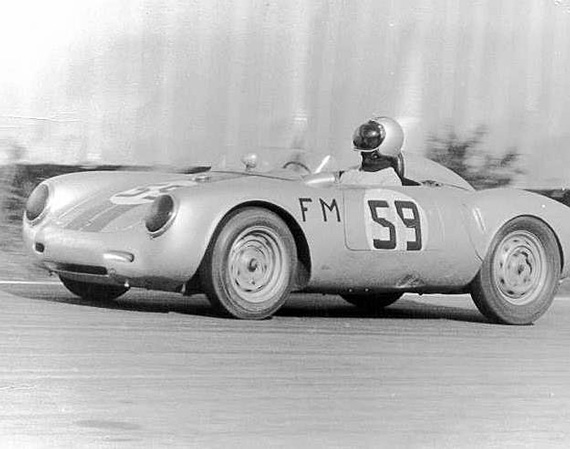
Dave Wolin goes back a long way; he got a bank loan to buy a used Porsche 550 Spyder for $2000 (that was a long time ago!) Today he is recording and preserving racing history and helping retired race drivers.
By Brandes Elitch
All photos courtesy Dave Wolin
You will not be surprised to learn that there is no pension plan for retired race car drivers like there is in the movie industry; they often depend on the kindness of strangers During the Monterey Historics this year, there will be a new and very special event, called “Tribute to the CanAm – 50th Anniversary.” Proceeds benefit the Racing History Project, (www.racinghistoryproject.com) and specifically two drivers: Charlie Hayes and Tony Adamowicz.
The stranger, in this case, is Dave Wolin, who has hosted previous events, such as “Legends of Riverside,” (honoring Dan Gurney, Carroll Shelby, Bob Bondurant and a few others), and “Tribute to the USRRC.” Dave has put together a night that people will remember for a long time. Iconic automobilist Toly Arutunoff will show never before seen footage of the 1971 Mid-Ohio and Watkins Glen races. Pete Lyons will give a slide presentation on the CanAm. Pete is the Riverside historian and did a book on the drivers of Riverside two years ago, which involved interviewing all the drivers who were available, some unfortunately no longer available. Pete is also one of the most knowledgeable people about the Ontario track as well. There will be a roundtable discussion with drivers, including book signings and an autograph session, as well as a memorabilia auction to benefit the two drivers.
Tony Adamowicz
Tony Adamowicz may not be a household name to younger readers, but he should be. In 1968, he won the SCCA Under Two Liter Trans-Am championship, which got him a ride for the 1969 F5000 season where, piloting a Gurney Eagle, he won the championship. In 1971 he teamed with Ronnie Bucknum in a NART Ferrari 512. They took third at Le Mans and second at Daytona. He then competed in CanAm, and, TransAm, and F5000. In 1981, he became the IMSA GTU winner and in 1982 he won another IMSA championship in the GTO category, and then amazingly won yet a third IMSA championship in 1983.
Unfortunately, at age 74, he suffered a seizure, later identified as a brain tumor. Dave’s mission is to raise funds to help Tony pay his bills and continue as best he can.
Charlie Hayes
Charlie Hayes is likewise a famous driver. He is also a well-known author, with titles such as “Fast and Faster, the Story of Charging Charlie Hayes,” and perhaps, by my count, a half dozen other books, including “Life After Death.” At one time, the magazine Autoweek counted him as one of the top ten worldwide racing drivers. He has had a fascinating life,including being a Ferrari dealer. Like many of us, he suffered a divorce, a bankruptcy, and a breakdown, but he survived to come out the other side and write books for the rest of us on how to survive. Right now, he has COPD. You can help him via: gofundme.com/pmekb65g.
Preserving history
I asked Dave about his background, and how he came to get involved with this mission. Aside from helping the drivers, Dave has another goal, which is to hear and record the stories from the original drivers, owners, crew chiefs, mechanics, race stewards, and everyone else who was involved in automobile racing that is still able to tell it as it was, and to preserve these histories. Some of these stories are already lost in translation, and not accurate, he says. The dinners go back twenty years, to when Carroll Shelby and Bob Bondurant spoke and showed slides. Vintage racing was coming along, but it was celebrating the cars, not the drivers, and as he says, not all of them could win. Dave started meeting as many racers as he could and taking notes. All of this needs to be preserved one way or another. Dave says he will continue to do this as long as he can. In the Fall, there will be another event at the NHRA museum in Pomona and possibly next spring as well. As he says, “The fiftieth anniversary of the CanAm is a no-brainer. He is also thinking about an event in Monterey in 2017, based on whatever theme the track chooses.
Dave grew up in the Northeast, and remembers vividly listening to the 1957 Indianapolis 500 race on the radio, won by Sam Hanks. Since then, as he says, the entire focus of his life has been involvement in all aspects of car racing and, he adds, “What better life can there be?” He started pro racing in Canada because you didn’t have to be 21 then, whereas you had to be 21 to have an SCCA license in the states. He raced an MGA; the entry fee was ten dollars, and the prize money was based on the size of the field. It could be as much as thirty dollars! At that time, BMC Canada gave support, including giving him twin cam motors, transmissions, etc. He was going to college, and working in a gas station for a dollar an hour, but he got a bank loan to buy a used Porsche 550 spyder, for $2000 (a car payment of $80 a month). A banker friend financed it, and he got a job at the local VW dealer, where the chief mechanic, who had trained at the factory, helped him with the motor. He went to Pensacola to the first USSRC race when he was 21 to see if he could compete but was told not to race it because it couldn’t compete with a Lotus 23. He was able to sell it and replace it with the Bob Holbert championship 1963 RS61, obsolete in 1967, which was available without a motor. He got an 8 cylinder motor from the factory, which blew up, at which point it was fitted with a four cylinder. This car is now in the Collier museum in Florida. Then after college, he got drafted, and after the service he went to California to see James Garner – he wanted to drive for him and do world championship stuff. He quickly found out he was not in that league, but he was hired to do public relations. Garner was a talented driver, and he produced a racing biopic, but decided never to release it. The script was written by now well-known author William Edgar.
Dave worked on a lot of movies and film festivals. He put together an auto film festival, featuring the Garner film. As Garner says in his book “The Garner Files,” “ We chronicled AIR’s 1969 season in “The Racing Scene,” a ninety minute documentary directed by former ABC sports director Andy Sidaris, and written by William Edgar. The film follows us as we race at Daytona, Sebring, and on the Formula A circuit at Lime Rock and St. Jovite. The title sequence shows Scooter Patrick and me driving in the Baja 1000.” He found Bruce Kessler’s Sound of Speed film, which won an award at Cannes and dug up more obscure films. He helped with the filming of “Winning” with Paul Newman, where his friend, Charlie Hayes got them connected after the 1968 Road America 500.
Dave’s career path has taken him though IMSA and SCCA Pro racing, where his teams won more than a few championships.
Dave is pleased with the success of the previous events he has organized, and he deserves full marks for this. Obviously, he cannot do it all himself. But there is reason for hope. When Steve Earle started the Monterey Historics at Laguna Seca, he wondered if enough cars would show up to field a day of racing. It didn’t happen overnight, but ultimately it became very successful worldwide, and even today old racecars are being found and restored. We cannot perform similar feats of restoration on the drivers of the time, but we can honor them and hear their stories and contribute to their expenses, and Dave must be commended himself for playing a leading role in this respect.
Tickets may still be available for this limited seating event – check the website. www.tributetothecanam.com . As always, it is one person who makes these things happen, in this case Dave Wolin.
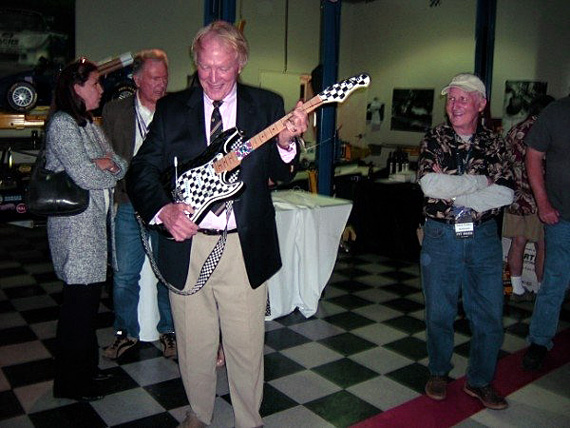

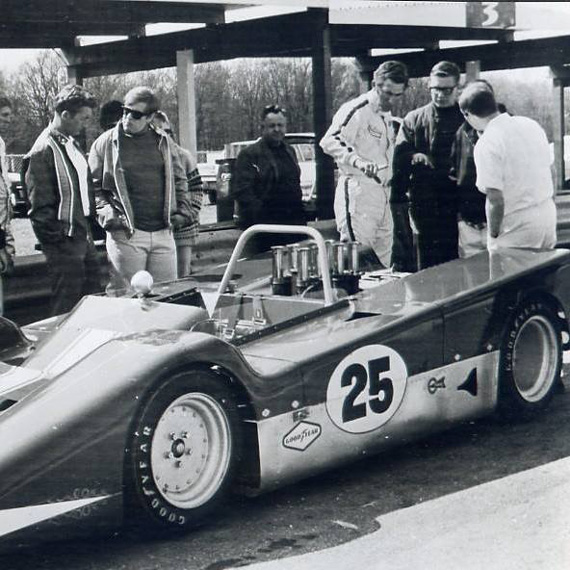
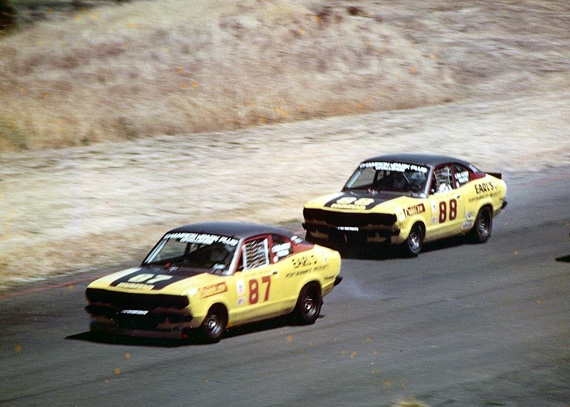
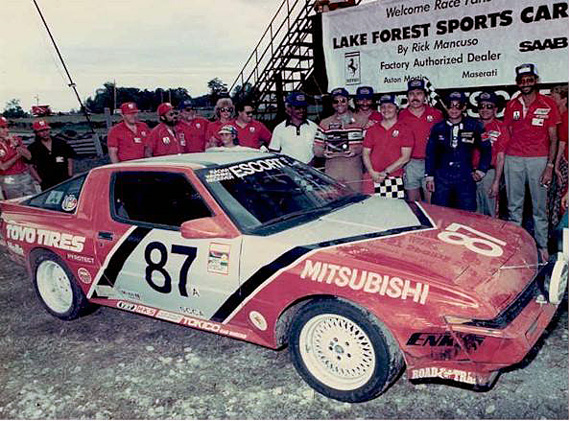
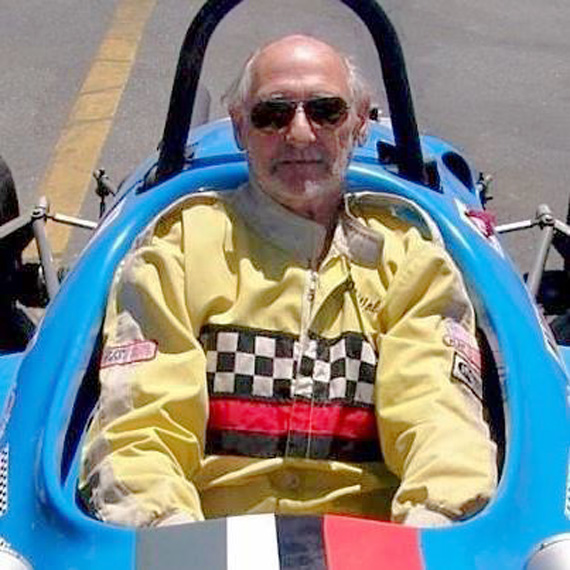
Pete, what a wonderful tribute to a man who can make things happen and get things done, Dave Wolin. Brandes Elitch’s excellent article on the man who keeps popping up all over the place with great events. I first met Dave at the “Fabulous Fifties” group Palos Verdes Concourse in 2007. I had a small display of my vintage sportscar photos of some of the drivers and cars that were there. Dave asked me if I would bring a large selection to his “Southern Yosemite Automotive Film Festival 2008” in Oakhurst, CA. This event then lead Dave to bring it down to the flat lands for the now famous “Legends of Riverside” events. Historically yours, Allen R Kuhn.
All of us interested in the magical racing of the 50s and 60s owe a lot to Dave for his tireless efforts to document and preserve those memories. A true unsung hero that continues to carry the torch for the rest of us. Rex McAfee